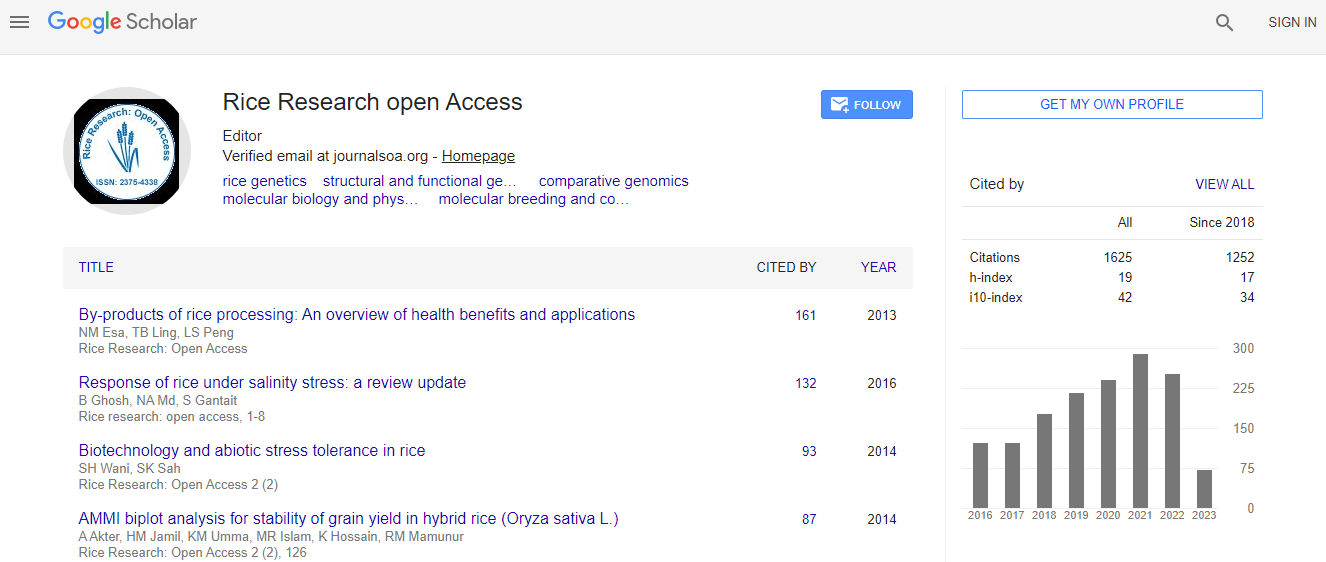Research Article
Phenotypic Characterization on Selected Kenyan and Tanzanian Rice (Oryza sativa L) Populations Based on Grain Morphological Traits
| Wambua F Kioko1*, Musyoki A Mawia1, Ngugi M Piero1, Karau G Muriira2, Nyamai D Wavinya1, Lagat R Chemutai1, Matheri Felix1, Arika W Makori1 and Njagi S Mwenda1 | |
| 1Department of Biochemistry and Biotechnology, School of Pure and Applied Sciences, Kenyatta University, P.O. Box 43844-00100, Nairobi, Kenya | |
| 2Molecular Biology Laboratory, Kenya Bureau of standards, P.O. Box 54974-00200, Nairobi, Kenya | |
| Corresponding Author : | Wambua F Kioko Department of Biochemistry and Biotechnology School of Pure and Applied Sciences Kenyatta University, P.O. Box 43844-00100 Nairobi, Kenya Tel: +254718507667 E-mail: festuswambua101@gmail.com, festus.w@students.ku.ac.ke |
| Received: October 06, 2015; Accepted: November 17, 2015; Published: November 20, 2015 | |
| Citation: Kioko WF, Mawia MA, Piero NM, Muriira KG, Wavinya ND, et al. (2015) Phenotypic Characterization on Selected Kenyan and Tanzanian Rice (Oryza sativa L) Populations Based on Grain Morphological Traits. J Rice Res 3:155. doi:10.4172/2375-4338.1000155 | |
| Copyright: © 2015 Kioko WF, et al. This is an open-access article distributed under the terms of the Creative Commons Attribution License, which permits unrestricted use, distribution, and reproduction in any medium, provided the original author and source are credited. | |
| Related article at Pubmed, Scholar Google | |
Abstract
Phenotypic characterization of rice varieties is a good approach for assessing genetic and phenotypic variability among varieties and is key in grading of rice varieties. The objective of this study was to determine the major determinants of phenotypic diversity and the strength of segregation among aromatic and non-aromatic rice (Oryza sativa L) populations collected from Kenya and Tanzania. Multivariate analyses including principal component analysis (PCA) and cluster analysis were carried out assess the overall patterns of morphological variation. Using Principal component analysis, it was found that grain length, kernel length, grain weight and kernel length/breadth ratio are major drivers of the huge phenotypic diversity observed. Cluster analysis was found to effectively distinguish the majority of aromatic from non-aromatic varieties based on the grain quality traits evaluated where two distinct clusters were formed. The results obtained from this study demonstrated that phenotypic trait measurement can be relied upon in diversity studies among diverse and closely related genotypes. We conclude that this research which forms first part of rice grading gives an insight in to the general patterns of phenotypic diversity and finds out the most important distinguishing characters. This will be validated with subsequent molecular analysis.

 Spanish
Spanish  Chinese
Chinese  Russian
Russian  German
German  French
French  Japanese
Japanese  Portuguese
Portuguese  Hindi
Hindi 
